

Olympus BX63: Combine this all-round laboratory microscope with state-of-the-art camera technology – with our LM adapter solutions!
Modern digital SLR cameras, mirrorless system cameras and high-quality C-mount cameras maximise the advantages of the acclaimed Olympus UIS2 optical system, delivering superior image quality
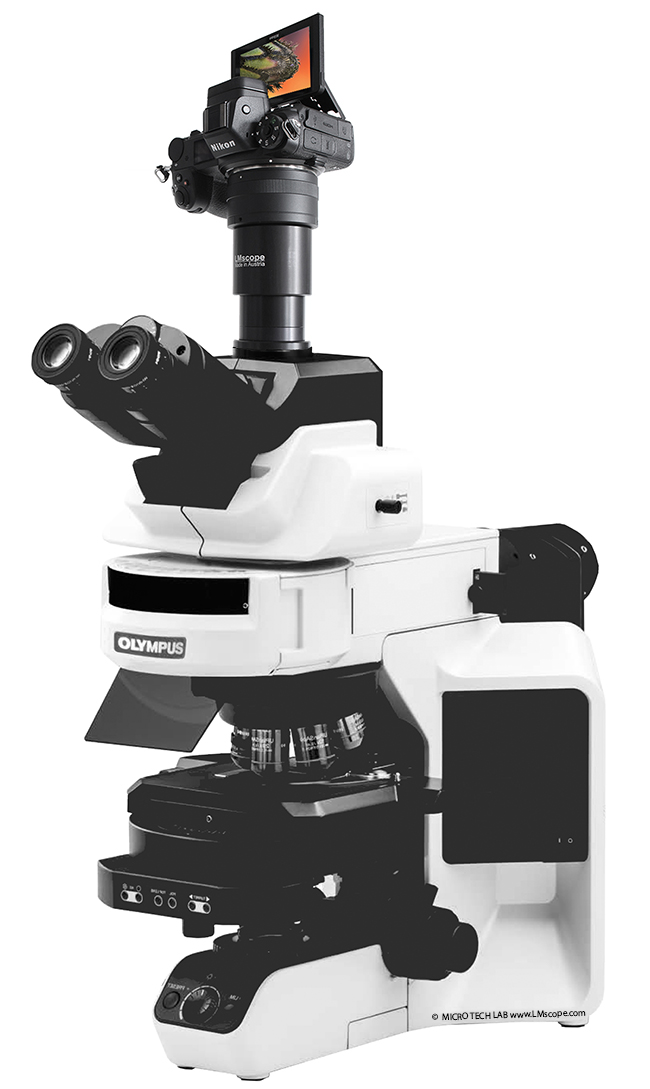
The Olympus BX63 is an upright laboratory microscope with an infinity-corrected optical system that stands out through its versatility. Originally launched in 2010, it underwent a redesign in 2022. Because it features a modular design, the BX63 supports an extensive array of transmitted and reflected light observation methods: brightfield (1.25x to 100x), darkfield (10x to 100x), phase contrast (10x to 100x), fluorescence, Nomarski DIC and simple polarised light. Accordingly, the microscope is suitable for a broad range of industrial, clinical and laboratory applications. Depending on the configuration, the microscope weighs at least 35 kg and is therefore ideal for photomicrography, as the greater weight reduces vibration.
The BX63 system is designed for use with Olympus’s broad range of UIS2 objective lenses, renowned for their ultra-sharp, brilliant images. They are housed in the reverse-facing 7-position nosepiece and are RMS threaded. The following lens types are available: PlanApo, Achromat, Plan, Apochromat, S Plan, Fluorite, Plan Fluorite and Olympus’s X line objectives for improved image quality in fluorescence imaging applications (chromatic aberration 400–1,000). The nosepiece is motorised and coded. The maximum working distance is 17 mm (with a UPLFLN4X objective lens).
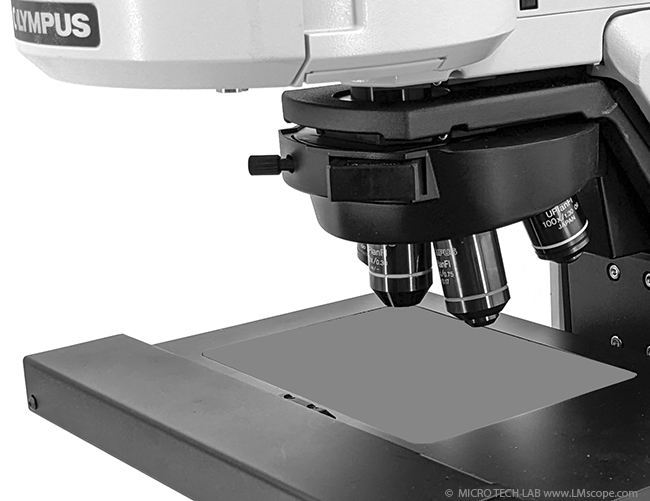
Other parts of the microscope are motorised as well: fluorescence mirror and illuminators, illumination control, field diaphragm, universal condenser, ultrasonic stage. There are two kinds of illumination methods: LED and 12V/100W halogen lamps. The microscope also has an 8-position fluorescence illuminator (halogen, xenon) for 8 mirrors.
A range of tubes are available for the BX63. We recommend a trinocular tube for photomicrography applications; specifically one of the following:
- U-ETR-4
- U-TR30NIR
- U-TR30-2
- U-TTR-2
- If your microscope is equipped with a binocular tube, you can also upgrade it with the U-TRU intermediate tube.
With our LM adapter solutions, a wide range of camera types – DSLRs, mirrorless system cameras or high-quality C-mount cameras – can be attached to the microscope.
Current mirrorless system cameras and SLRs use large, high-quality sensors. With their wide dynamic range and high light sensitivity, these cameras deliver outstanding image quality. The majority of cameras can be controlled remotely from the computer in Live View. For more information on making a camera selection, please see the following info page:
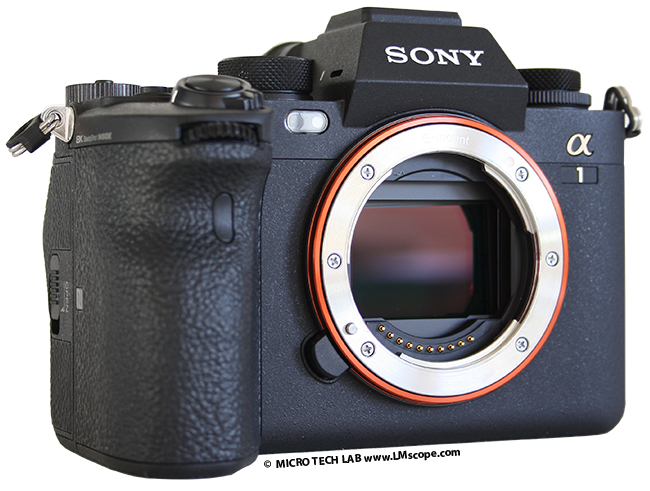
We recommend attaching the camera directly to the phototube (42 mm internal diameter), as is shown in the image below (using a focusable LM direct adapter):
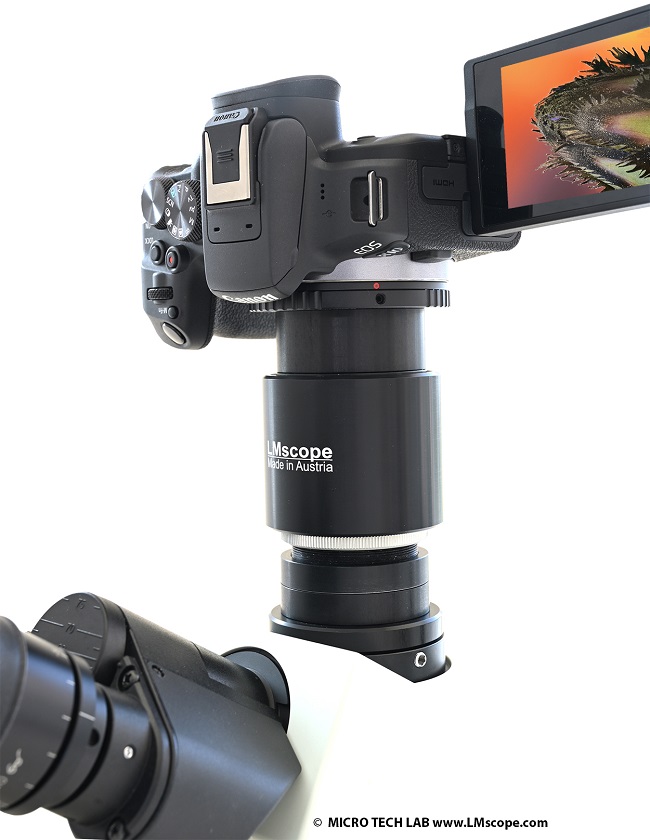
Alternatively, original C-mount 1x tubes are available (U-TV1xC, U-TV2x-2 + U-CMAD3). The widefield “Pro” adapters are matched to the camera’s sensor size and are an exact fit for these tube versions. C-mount ports with built-in reduction optics (0.5x, 0.63, 0.7x, 0.8x), which are used for conventional C-mount cameras, are not recommended for cameras with large sensors because the reduction optics can cause vignetting and blurring at the edges of the image.
Alternatively, the camera can also be attached to the eyepiece tube (30 mm internal diameter) of the microscope. To attach the camera, one eyepiece is removed and the camera, together with the adapter unit, is inserted into the tube where the eyepiece was. This method is very flexible and can be used with a large number of microscopes with a standard eyepiece tube. Consequently, even microscopes lacking a dedicated phototube can be used for photomicrography without any particular effort.
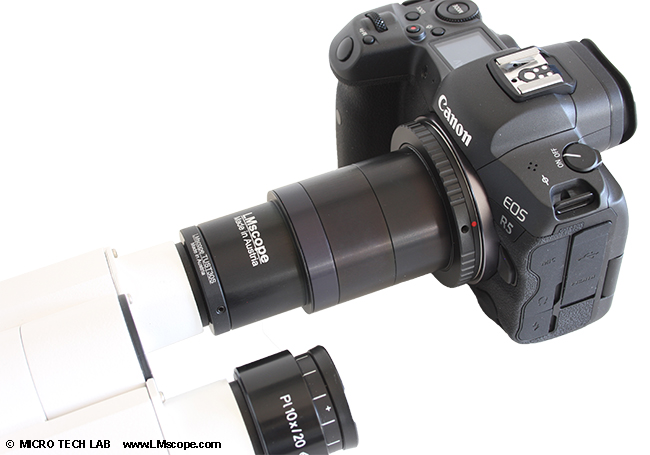
The Olympus BX63 does not have an integrated display. However, the detachable and freely positional U-MCZ controller can be used to control a wide range of settings:
- Observation method
- Objective lens
- Mirror unit changeover
- Light intensity adjustment
- Live/archive image selection
A touch panel controller is also available as an option. For use with these controllers, Olympus recommends the fee-based cellSens imaging software, which is available in three versions (Entry, Standard and Dimension). The cellSens software can also be used to control the C-mount cameras advertised by Olympus (e.g. DP72, DP74, DP25, DP21). Beyond taking and processing images, cellSens also offers tools to conduct analyses, generate reports and make editing changes in a database. Additionally, the software supports deconvolution and image stitching (the creation of a large image from various smaller, individual photographic images).
Conclusion: Its high-performance optical system and modular design with different tube options make the Olympus BX63 a great fit for photomicrography. With our LM microscope adapters, a wide range of digital cameras can be used with this microscope. For additional information or if you have any questions, please feel free to reach out to us.
10.11.2023Photography:
Fitting the microscope to digital single-lens reflex (DSLR), mirrorless interchangeable-lens cameras (MILC ), digital single-lens mirrorless (DSLM) or C-mount cameras is easy with our LM digital SLR adapters, which feature a plan achromatic optical system. Our products make it possible to capture top-quality microscope images. To help you select the adapter that is right for your camera, we have set up an online configurator on our website. You can also email us – ideally with attached photographs of your microscope.
Modern DSLR and single-lens mirrorless (DSLM) offer the latest technology and are generally very well suited for microscopy applications. Most of them can be controlled remotely via PC/Mac. Because of their high sales volumes, they offer an excellent price/performance ratio compared to special-purpose microscope cameras.
Features of top DSLR and single-lens mirrorless cameras (DSLM):
- Large, powerful full-frame sensors (36 x 24 mm)
- Sensor resolution of 61 megapixels or 240 megapixels with Pixel Shift technology
- High light sensitivity (ISO 400,000+)
- Extensive dynamic range (up to 15 aperture stops/f-stops)
- Short exposure times (1/8000 second) up to 1/32,000 seconds using the digital shutter
- 4K Ultra HD or 8K Ultra HD video function
- Live video capture on external monitors in ultra HD quality
In most cases, these cameras are significantly more powerful than microscope cameras with smaller sensors (1/2" or 2/3"). On our website you will find our current camera recommendations and a camera ranking which is specifically tailored to microscopy applications.